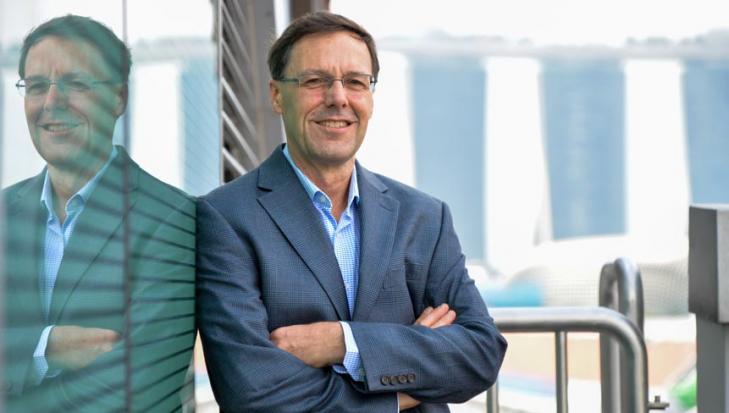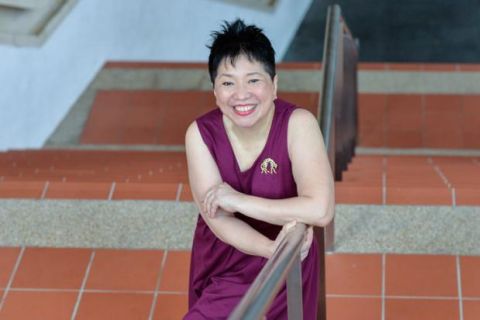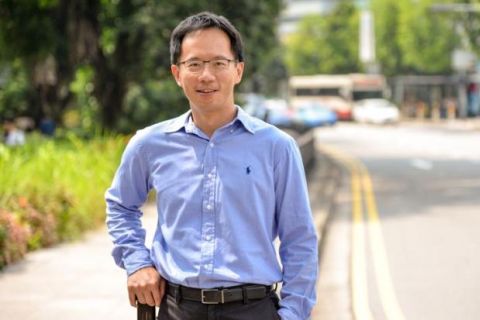
Professor Don Ferrin at SMU Lee Kong Chian School of Business studies the factors influencing trust in organisations and what happens when that trust is damaged.

Photo Credit: Cyril Ng
By Yamini Chinnuswamy
SMU Office of Research (15 Sep 2014) – Trust is a central facet of human interactions in both private and professional spheres. But how does one earn trust, and what are some of the strategies for repairing trust once it has been violated? For the past 20 years, Professor Don Ferrin at SMU Lee Kong Chian School of Business has made it his calling to explore these questions and unravel the science underlying trust.
His journey into the field might be considered unconventional. “Before I was an academic, I was a certified public accountant. I disliked accounting, but I found the people side of it completely fascinating,” he says. “As a topic, trust is as far away as possible from the black-and-white dollars and cents of accounting. Trust is intangible and enigmatic—yet a central aspect of every human relationship.”
Professor Ferrin acknowledges that these same characteristics make trust a challenging topic to study, but it has not stopped him from delving into the many different paradigms of trust and how they relate to interpersonal dynamics.
Whom to trust, and why?
Being a business school professor, Professor Ferrin focuses specifically on trust in organisational settings: the trust that workers have in their leaders and in each other, the trust that a leader has in his or her subordinates and the ways in which individuals and organisations benefit from trust. By building a network map of these different relationships, Professor Ferrin says, an overall pattern can be determined.
Indeed, one of his favourite contributions to the plethora of trust research is a study of trust networks in a company.
“We measured how much every single person trusted every other person in the organisation. My expectation was that if you wanted to understand how much Person A trusts Person B, and vice versa, there would be two aspects. One would be how they interact with each other. The other would be the third parties that connect them. My expectation was that the former would be the major influence, and that the latter would explain some additional variance,” he says.
“But what we found was the complete opposite: third party connections had the majority influence! I was shocked, because this meant people were not relying primarily on their own interactions to judge another person. Rather, they were relying primarily on what they had learnt from other people about whether the person was trustworthy.”
While trust can be studied by surveying company employees, the study of trust repair is a trickier beast.
“Because one cannot anticipate a trust violation,” Professor Ferrin explains. “By the time we—as researchers—are aware of a violation, it is too late to study it, except retrospectively. And violations and responses tend to be idiosyncratic, making them difficult to study systematically.”
To get around this problem, Professor Ferrin used the case study of a real trust violation that occurred in a Fortune 500 company.
“In this case, a CEO of the company had violated his employees’ trust. First, he denied the violation. This did not work. Then he tried to explain himself. That did not work. He followed up with an apology, which did not work either. After that, he offered to reduce his salary. Finally, he resigned.”
“Using this as a model, we hired actors to re-create this scenario in a studio: basically bringing this real-life situation into the lab. We were able to take a scientific approach to measuring how effective each response was—denial, apology, penance, resignation and so on,” he shares.
One aspect of trust repair that Professor Ferrin was particularly interested in was whether the initial perception of the violation mattered: for example, whether it was perceived as a competence violation or an integrity violation.
“One thing we found over and over was that for competence violations, an apology tended to be quite effective, even more so than a denial. But for integrity violations, we observed that a denial was more effective than an apology,” he adds. “Of course, our research also showed that it was most important to be truthful when responding to any allegation of a violation.”
Out of the lab, and into the real world
Due to his focus on the science of trust in business and organisational settings, Professor Ferrin has been approached by companies to apply his research findings to training applications. One company with internal and external trust issues asked him and his collaborators to construct a half-day training workshop on the topic for 800 of its global leaders.
“In our daily lives, when we use the word trust, we mean a lot of different things. For example—you trust me, but you might refer to my competence, integrity, or benevolence. So the first step in our programme was to help the group of leaders understand what trust is, asking them to identify a trust relationship they wanted to improve,” Professor Ferrin says.
“The elements of trust—ability, benevolence, and integrity—can be used as diagnostic tools to find weaknesses in a relationship and pinpoint areas to focus on, such as communication.”
However, Professor Ferrin is quick to point out that a half-day session like this is just the first step in addressing trust challenges in large, complex organisations. Rather, he says, measuring and managing trust using scientifically validated tools should be a long-term goal for all companies, though getting companies to buy into this can be a challenge.
“Trust is unlike most other organisational issues. After all, people find it hard to tell their bosses that they don’t trust them!” he quips. “As a result, people do not talk enough about trust problems, and it’s difficult to get organisations to start talking about them without them feeling as if their leadership is being questioned.”
Moving forward, he hopes that more will be done to translate scientific findings on trust into training materials and other pedagogical approaches; not least because it will continue to be a highly relevant topic.
“When I was growing up, I think most people felt that we could trust big corporations like banks and insurance companies, and also the media,” says Professor Ferrin. “Nowadays, these are some of the least trusted organisations in the world. It’s unfortunate, but the increasing number of trust problems in the business world makes it all the more important for us to continue studying trust, and to translate our findings into useful tools for addressing trust problems in the business world and beyond.”
See More News
Want to see more of SMU Research?
Sign up for Research@SMU e-newslettter to know more about our research and research-related events!
If you would like to remove yourself from all our mailing list, please visit https://eservices.smu.edu.sg/internet/DNC/Default.aspx

